Page 84 of 769
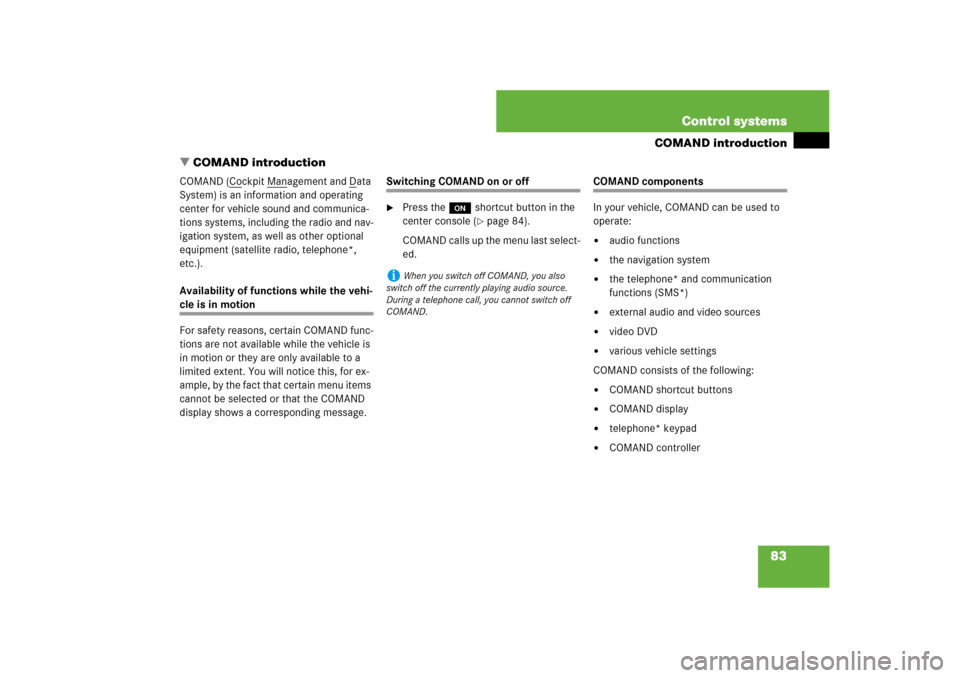
83 Control systems
COMAND introduction
�COMAND introduction
COMAND (C
ockpit M
anagement and D
ata
System) is an information and operating
center for vehicle sound and communica-
tions systems, including the radio and nav-
igation system, as well as other optional
equipment (satellite radio, telephone*,
etc.).
Availability of functions while the vehi-
cle is in motion
For safety reasons, certain COMAND func-
tions are not available while the vehicle is
in motion or they are only available to a
limited extent. You will notice this, for ex-
ample, by the fact that certain menu items
cannot be selected or that the COMAND
display shows a corresponding message.
Switching COMAND on or off�
Press the o shortcut button in the
center console (
�page 84).
COMAND calls up the menu last select-
ed.
COMAND components
In your vehicle, COMAND can be used to
operate:�
audio functions
�
the navigation system
�
the telephone* and communication
functions (SMS*)
�
external audio and video sources
�
video DVD
�
various vehicle settings
COMAND consists of the following:
�
COMAND shortcut buttons
�
COMAND display
�
telephone* keypad
�
COMAND controller
i
When you switch off COMAND, you also
switch off the currently playing audio source.
During a telephone call, you cannot switch off
COMAND.
Page 96 of 769
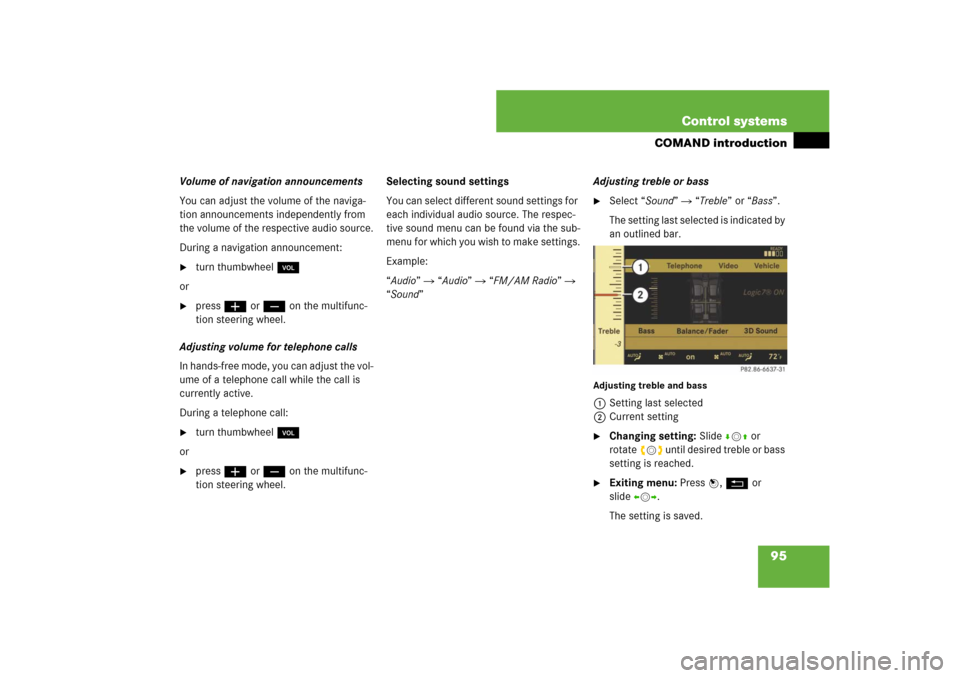
95 Control systems
COMAND introduction
Volume of navigation announcements
You can adjust the volume of the naviga-
tion announcements independently from
the volume of the respective audio source.
During a navigation announcement:�
turn thumbwheel,
or
�
pressæ or ç on the multifunc-
tion steering wheel.
Adjusting volume for telephone calls
In hands-free mode, you can adjust the vol-
ume of a telephone call while the call is
currently active.
During a telephone call:
�
turn thumbwheel,
or
�
pressæ or ç on the multifunc-
tion steering wheel.Selecting sound settings
You can select different sound settings for
each individual audio source. The respec-
tive sound menu can be found via the sub-
menu for which you wish to make settings.
Example:
“Audio” � “Audio” � “FM/AM Radio” �
“Sound” Adjusting treble or bass
�
Select “Sound” � “Treble” or “Bass”.
The setting last selected is indicated by
an outlined bar.
Adjusting treble and bass1Setting last selected
2Current setting�
Changing setting: Slide rmq or
rotateymz until desired treble or bass
setting is reached.
�
Exiting menu: Press n, L or
slideomp.
The setting is saved.
Page 109 of 769
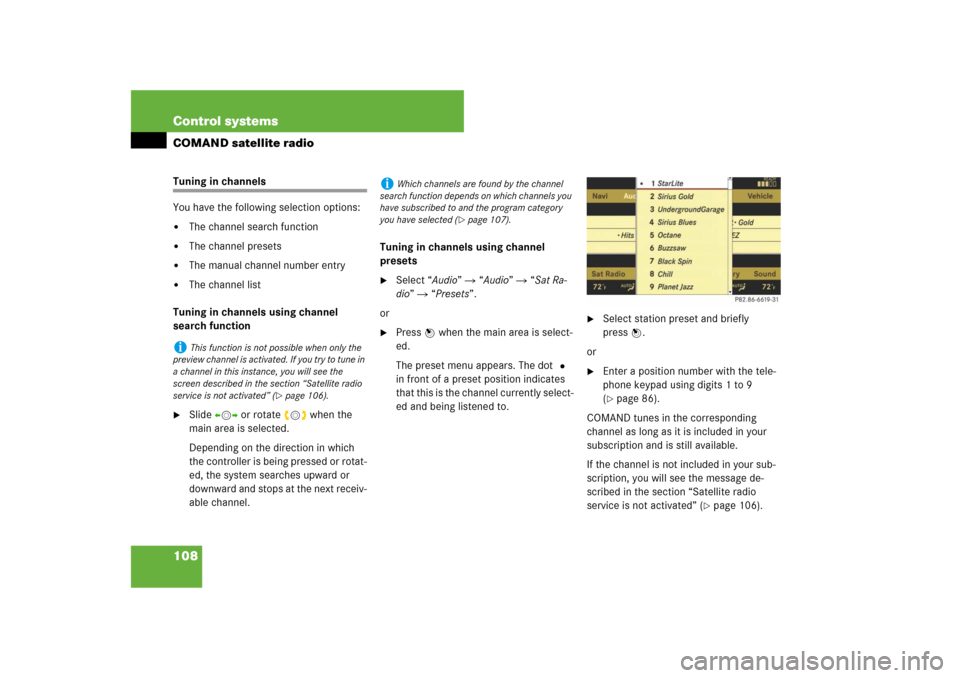
108 Control systemsCOMAND satellite radioTuning in channels
You have the following selection options:�
The channel search function
�
The channel presets
�
The manual channel number entry
�
The channel list
Tuning in channels using channel
search function
�
Slide omp or rotate ymz when the
main area is selected.
Depending on the direction in which
the controller is being pressed or rotat-
ed, the system searches upward or
downward and stops at the next receiv-
able channel.Tuning in channels using channel
presets
�
Select “Audio” � “Audio” � “Sat Ra-
dio” � “Presets”.
or
�
Press n when the main area is select-
ed.
The preset menu appears. The dotR
in front of a preset position indicates
that this is the channel currently select-
ed and being listened to.
�
Select station preset and briefly
pressn.
or
�
Enter a position number with the tele-
phone keypad using digits 1 to 9
(�page 86).
COMAND tunes in the corresponding
channel as long as it is included in your
subscription and is still available.
If the channel is not included in your sub-
scription, you will see the message de-
scribed in the section “Satellite radio
service is not activated” (
�page 106).
i
This function is not possible when only the
preview channel is activated. If you try to tune in
a channel in this instance, you will see the
screen described in the section “Satellite radio
service is not activated” (
�page 106).
i
Which channels are found by the channel
search function depends on which channels you
have subscribed to and the program category
you have selected (
�page 107).
Page 115 of 769
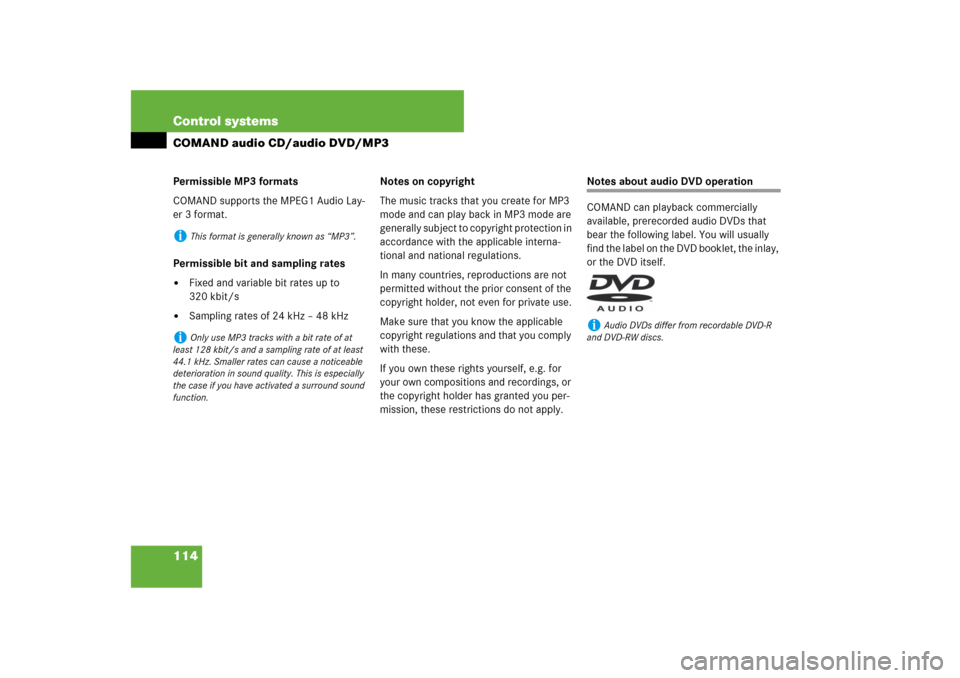
114 Control systemsCOMAND audio CD/audio DVD/MP3Permissible MP3 formats
COMAND supports the MPEG1 Audio Lay-
er 3 format.
Permissible bit and sampling rates�
Fixed and variable bit rates up to
320 kbit/s
�
Sampling rates of 24 kHz – 48 kHzNotes on copyright
The music tracks that you create for MP3
mode and can play back in MP3 mode are
generally subject to copyright protection in
accordance with the applicable interna-
tional and national regulations.
In many countries, reproductions are not
permitted without the prior consent of the
copyright holder, not even for private use.
Make sure that you know the applicable
copyright regulations and that you comply
with these.
If you own these rights yourself, e.g. for
your own compositions and recordings, or
the copyright holder has granted you per-
mission, these restrictions do not apply.
Notes about audio DVD operation
COMAND can playback commercially
available, prerecorded audio DVDs that
bear the following label. You will usually
find the label on the DVD booklet, the inlay,
or the DVD itself.
i
This format is generally known as “MP3”.
i
Only use MP3 tracks with a bit rate of at
least 128 kbit/s and a sampling rate of at least
44.1 kHz. Smaller rates can cause a noticeable
deterioration in sound quality. This is especially
the case if you have activated a surround sound
function.
i
Audio DVDs differ from recordable DVD-R
and DVD-RW discs.
Page 117 of 769
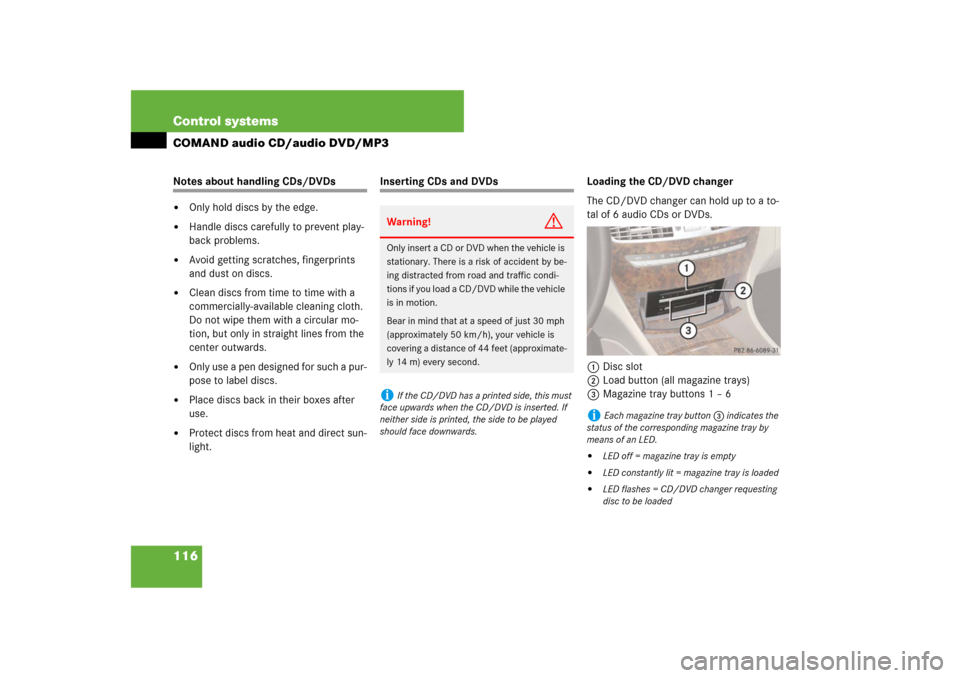
116 Control systemsCOMAND audio CD/audio DVD/MP3Notes about handling CDs/DVDs �
Only hold discs by the edge.
�
Handle discs carefully to prevent play-
back problems.
�
Avoid getting scratches, fingerprints
and dust on discs.
�
Clean discs from time to time with a
commercially-available cleaning cloth.
Do not wipe them with a circular mo-
tion, but only in straight lines from the
center outwards.
�
Only use a pen designed for such a pur-
pose to label discs.
�
Place discs back in their boxes after
use.
�
Protect discs from heat and direct sun-
light.
Inserting CDs and DVDs Loading the CD/DVD changer
The CD/DVD changer can hold up to a to-
tal of 6 audio CDs or DVDs.
1Disc slot
2Load button (all magazine trays)
3Magazine tray buttons 1 – 6Warning!
G
Only insert a CD or DVD when the vehicle is
stationary. There is a risk of accident by be-
ing distracted from road and traffic condi-
tions if you load a CD/DVD while the vehicle
is in motion.
Bear in mind that at a speed of just 30 mph
(approximately 50 km/h), your vehicle is
covering a distance of 44 feet (approximate-
ly 14 m) every second.i
If the CD/DVD has a printed side, this must
face upwards when the CD/DVD is inserted. If
neither side is printed, the side to be played
should face downwards.
i
Each magazine tray button3 indicates the
status of the corresponding magazine tray by
means of an LED.
�
LED off = magazine tray is empty
�
LED constantly lit = magazine tray is loaded
�
LED flashes = CD/DVD changer requesting
disc to be loaded
Page 118 of 769
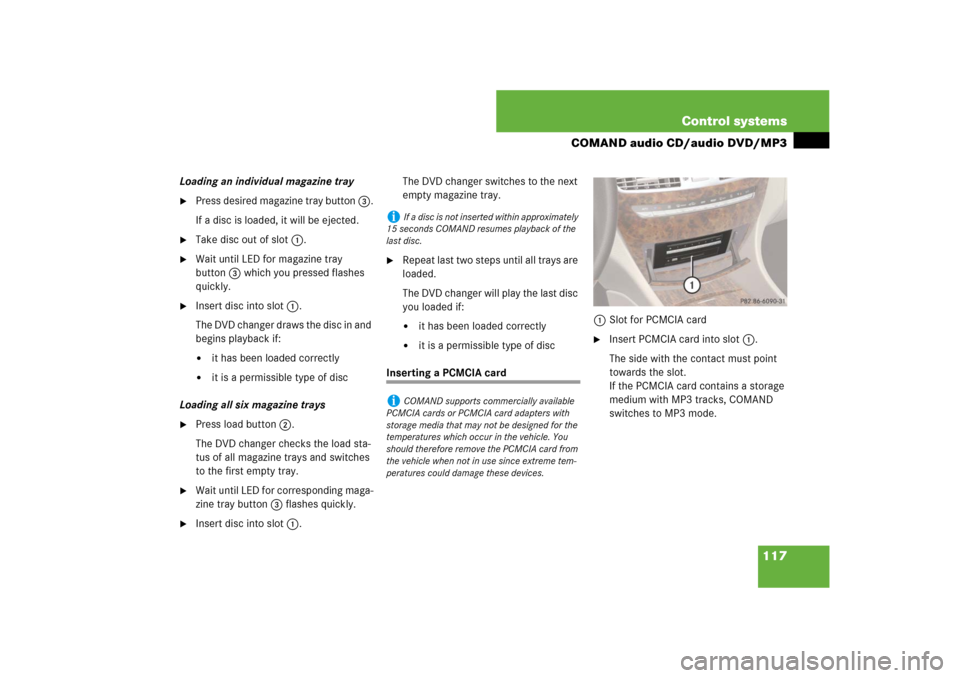
117 Control systems
COMAND audio CD/audio DVD/MP3
Loading an individual magazine tray�
Press desired magazine tray button 3.
If a disc is loaded, it will be ejected.
�
Take disc out of slot 1.
�
Wait until LED for magazine tray
button3 which you pressed flashes
quickly.
�
Insert disc into slot 1.
The DVD changer draws the disc in and
begins playback if:�
it has been loaded correctly
�
it is a permissible type of disc
Loading all six magazine trays
�
Press load button 2.
The DVD changer checks the load sta-
tus of all magazine trays and switches
to the first empty tray.
�
Wait until LED for corresponding maga-
zine tray button 3 flashes quickly.
�
Insert disc into slot 1.The DVD changer switches to the next
empty magazine tray.
�
Repeat last two steps until all trays are
loaded.
The DVD changer will play the last disc
you loaded if:�
it has been loaded correctly
�
it is a permissible type of disc
Inserting a PCMCIA card1Slot for PCMCIA card
�
Insert PCMCIA card into slot 1.
The side with the contact must point
towards the slot.
If the PCMCIA card contains a storage
medium with MP3 tracks, COMAND
switches to MP3 mode.
i
If a disc is not inserted within approximately
15 seconds COMAND resumes playback of the
last disc.
i
COMAND supports commercially available
PCMCIA cards or PCMCIA card adapters with
storage media that may not be designed for the
temperatures which occur in the vehicle. You
should therefore remove the PCMCIA card from
the vehicle when not in use since extreme tem-
peratures could damage these devices.
Page 124 of 769

123 Control systems
COMAND audio CD/audio DVD/MP3
Selecting a track using the telephone
keypad�
Press> on the telephone keypad
(�page 86).
�
Enter track number using the A-
9 buttons.
Fast forward/rewind �
Select main area.
�
Slide and hold omp until desired place
is reached.
Selecting a folder�
Select “Audio” � “Audio” � “MP3” �
“Folder”.
or
�
Press n when main area is selected.
The track list of the current folder ap-
pears.This is what the illustration in the right
column is showing as well.
1Back folder symbol
2Current track symbol
3Track symbol
�
Selecting one folder higher: Select
the Q symbol.
The display changes to the next folder
up in the folder structure on the disc.1Back folder symbol
2Current folder symbol
3Folder symbol containing tracks
�
Selecting a folder: Select desired
folder.
You will see the tracks in the folder.
�
Select a track.
The track is played and the correspond-
ing folder is now the active folder.
i
This function is only available in audio MP3
mode.
Page 125 of 769
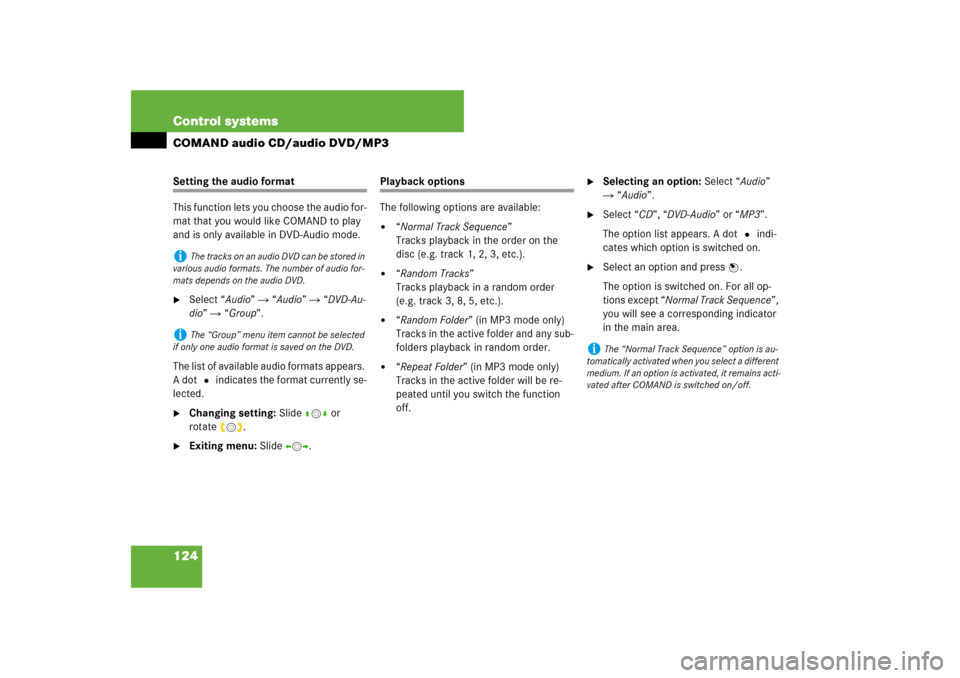
124 Control systemsCOMAND audio CD/audio DVD/MP3Setting the audio format
This function lets you choose the audio for-
mat that you would like COMAND to play
and is only available in DVD-Audio mode.�
Select “Audio” � “Audio” � “DVD-Au-
dio” � “Group”.
The list of available audio formats appears.
A dot R indicates the format currently se-
lected.
�
Changing setting: Slide qmr or
rotateymz.
�
Exiting menu: Slide omp.
Playback options
The following options are available:�
“Normal Track Sequence”
Tracks playback in the order on the
disc (e.g. track 1, 2, 3, etc.).
�
“Random Tracks”
Tracks playback in a random order
(e.g. track 3, 8, 5, etc.).
�
“Random Folder” (in MP3 mode only)
Tracks in the active folder and any sub-
folders playback in random order.
�
“Repeat Folder” (in MP3 mode only)
Tracks in the active folder will be re-
peated until you switch the function
off.
�
Selecting an option: Select “Audio”
� “Audio”.
�
Select “CD”, “DVD-Audio” or “MP3”.
The option list appears. A dot R indi-
cates which option is switched on.
�
Select an option and press n.
The option is switched on. For all op-
tions except “Normal Track Sequence”,
you will see a corresponding indicator
in the main area.
i
The tracks on an audio DVD can be stored in
various audio formats. The number of audio for-
mats depends on the audio DVD.
i
The “Group” menu item cannot be selected
if only one audio format is saved on the DVD.
i
The “Normal Track Sequence” option is au-
tomatically activated when you select a different
medium. If an option is activated, it remains acti-
vated after COMAND is switched on/off.